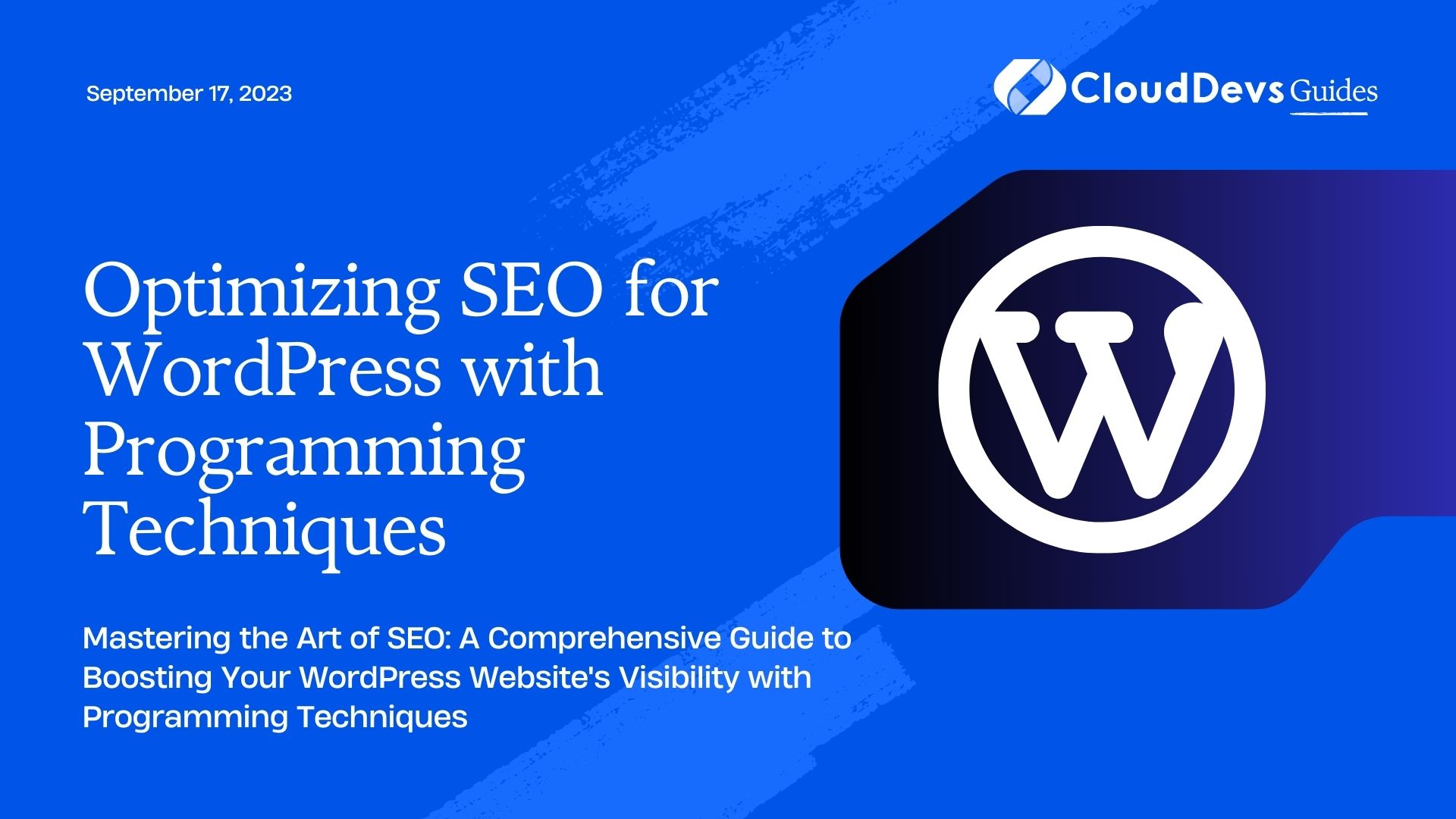Optimizing SEO for WordPress with Programming Techniques
In today’s digital age, having a strong online presence is crucial for any business or individual. Search Engine Optimization (SEO) plays a vital role in increasing the visibility and ranking of websites on search engine result pages (SERPs). If you have a WordPress website, you’re in luck! WordPress is a powerful and flexible platform, and with the right programming techniques, you can optimize your site’s SEO and attract more organic traffic. In this blog, we’ll explore various methods to enhance your WordPress website’s SEO using programming and coding practices.
1. Understanding the Importance of SEO for WordPress
Before diving into the technical aspects, it’s essential to grasp the significance of SEO for your WordPress website. A well-optimized website improves its chances of ranking higher on search engines like Google, Bing, and Yahoo. Higher rankings mean increased visibility, leading to more organic traffic and potential customers.
To begin, ensure your website has valuable and relevant content for your target audience. Google and other search engines prioritize content that caters to user intent and provides genuine value. With this foundation in mind, let’s delve into the technical aspects of optimizing SEO for WordPress.
2. Keyword Research and Implementation
Keyword Research:
The first step in optimizing SEO is keyword research. Identify relevant keywords and phrases that users might use to find your content. There are numerous tools available, such as Google Keyword Planner, SEMrush, or Ahrefs, to help you find valuable keywords. Aim for a mix of high-volume and long-tail keywords to reach a broader audience.
Title Tags and Meta Descriptions:
Once you have your keywords, strategically place them in your title tags and meta descriptions. Title tags should be concise (around 60 characters) and include the primary keyword for the page. Meta descriptions should provide a brief overview of the page’s content (around 150 characters) and entice users to click through.
Code Sample – Adding Title Tag and Meta Description:
html <head> <title><?php echo get_the_title(); ?></title> <meta name="description" content="<?php echo get_the_excerpt(); ?>"> </head>
3. Optimizing Website Performance
Page Loading Speed:
Site speed is a crucial ranking factor for search engines. Optimizing your website’s performance will not only improve SEO but also enhance user experience. Compress images, leverage browser caching, and minimize HTTP requests to reduce load times.
Caching:
Implement caching mechanisms to store frequently accessed data, such as database queries and HTML output. This reduces server load and improves page loading speed.
Code Sample – Implementing Caching with WP Super Cache plugin:
php
// Add caching for database queries
define('WP_CACHE', true);
// Enable Gzip compression
add_filter('wp_deflate_enabled', '__return_true');
add_filter('wp_gzip_enabled', '__return_true');
4. Mobile Responsiveness
Responsive Web Design:
With the majority of internet users accessing websites through mobile devices, having a mobile-responsive WordPress site is non-negotiable. Google prioritizes mobile-friendly sites and penalizes those that aren’t optimized for mobile.
Viewport Meta Tag:
Use the viewport meta tag to ensure your website adjusts correctly to different screen sizes, providing a seamless user experience on mobile devices.
Code Sample – Adding Viewport Meta Tag:
html <meta name="viewport" content="width=device-width, initial-scale=1">
5. Implementing Structured Data
Rich Snippets:
Incorporate structured data markup, such as JSON-LD or Microdata, to help search engines understand your content better. Rich snippets, like star ratings or event details, can increase the visibility and click-through rate of your pages.
Code Sample – Adding JSON-LD for a Product:
html
<script type="application/ld+json">
{
"@context": "https://schema.org/",
"@type": "Product",
"name": "Your Product Name",
"description": "Description of your product.",
"brand": "Your Brand",
"sku": "Product SKU",
"offers": {
"@type": "Offer",
"price": "Product Price",
"priceCurrency": "USD",
"availability": "https://schema.org/InStock"
}
}
</script>
6. Utilizing Permalinks
SEO-Friendly URLs:
Customize your permalinks to make them more SEO-friendly. Include relevant keywords in the URL structure to help search engines and users understand what the page is about.
Code Sample – Setting SEO-Friendly Permalinks in WordPress Admin Panel:
plaintext Go to Settings > Permalinks Select "Post Name" or "Custom Structure" and enter /%postname%/ or /%category%/%postname%/ respectively.
7. Optimizing Images
Image Optimization:
Compress images without compromising quality to reduce page load times. Use descriptive alt tags to provide context to search engines and improve accessibility.
Code Sample – Image Compression with Smush plugin:
php
// Automatic image compression with Smush
add_filter('wp_smush_auto', '__return_true');
8. Secure Your Website
SSL Certificate:
Implement an SSL certificate to ensure your site is served over HTTPS. HTTPS is now a ranking factor, and secure websites inspire trust among users.
Code Sample – Forcing HTTPS with a .htaccess rule:
plaintext
RewriteEngine On
RewriteCond %{HTTPS} off
RewriteRule ^(.*)$ https://%{HTTP_HOST}%{REQUEST_URI} [L,R=301,L]
9. Fixing Broken Links
Broken Link Checker:
Use plugins or custom scripts to check for broken links on your website regularly. Broken links can harm your SEO efforts and create a poor user experience.
Code Sample – Broken Link Checker using a WordPress plugin:
php
// Broken Link Checker Plugin
function check_broken_links() {
if ( function_exists( 'blc_output_error_console' ) ) {
blc_output_error_console();
}
}
add_action( 'init', 'check_broken_links' );
Conclusion
With the vast number of websites on the internet, optimizing your WordPress site for search engines is critical to stand out from the crowd. By employing the programming techniques and code samples discussed in this blog, you can significantly improve your website’s SEO and achieve higher rankings on SERPs. Remember that SEO is an ongoing process, and staying up-to-date with the latest trends and algorithms will help you maintain a strong online presence and drive organic traffic to your WordPress website. Happy optimizing!
Table of Contents








